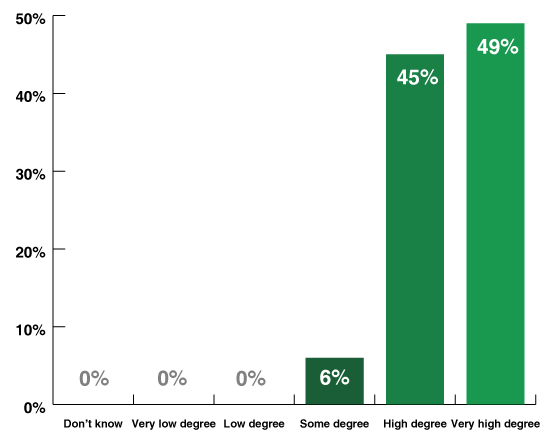ABC Softwork recently examined how employees from 37 Danish trade and production companies assess the ability of their workplace to create value. 92% believe they can improve their ability to deliver while maintaining a healthy stock level.
Cross-company cooperation is estimated to offer huge potential, but the responses also show how alarmingly few companies actually engage in such cooperation!
“I believe ongoing coordination and planning between sales, purchasing, logistics and production departments is essential”
The chart shows that 94% believe a cross-company process is important for achieving the goal of high delivery ability coupled with low inventory levels. The cross-company planning process – also known as Sales & Operation planning – demonstrably enhances profitability (DAFA is a good example), but currently only 16% of the companies asked have developed and implemented such a process. This leaves 84% of Danish companies with a huge unexploited potential.
The five barriers
We asked the companies to list the main challenges when establishing an S&OP planning process, which internally synchronizes the company:
- Operations “devour” development activities (69%)
- The company acts and thinks in terms of silos (59%)
- Lack of a common data basis (44%)
- Knowledge about how to design a joint planning process (41%)
- Top management focus (30%)
Top management has to take responsibility
According to the survey, top management does not pose a barrier to implementing a joint planning process (an element of a super-optimized supply chain). Nevertheless, employees assess that operational tasks take large chunks of time.
At ABC Softwork we believe it is management’s responsibility to ensure optimal operations and planning. Since 88% of the companies interviewed believe a joint planning process is crucial for balancing inventory levels with ability to deliver, it follows that management has a responsibility to allocate development-oriented resources and to break down functional silos.

 ABC Softwork recently examined how employees from 37 Danish trade and production companies assess the ability of their workplace to create value. 92% believe they can improve their ability to deliver while maintaining a healthy stock level.
ABC Softwork recently examined how employees from 37 Danish trade and production companies assess the ability of their workplace to create value. 92% believe they can improve their ability to deliver while maintaining a healthy stock level.